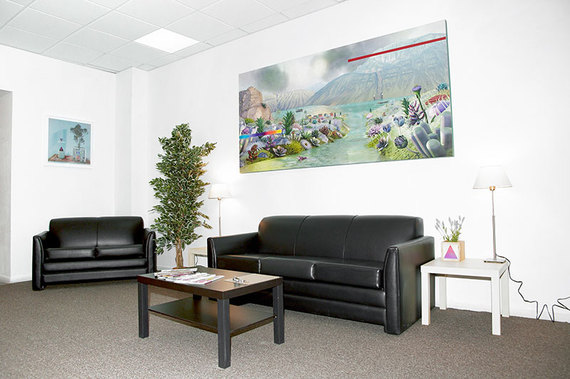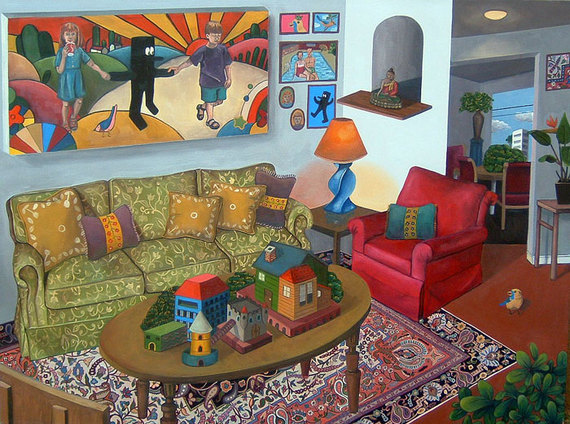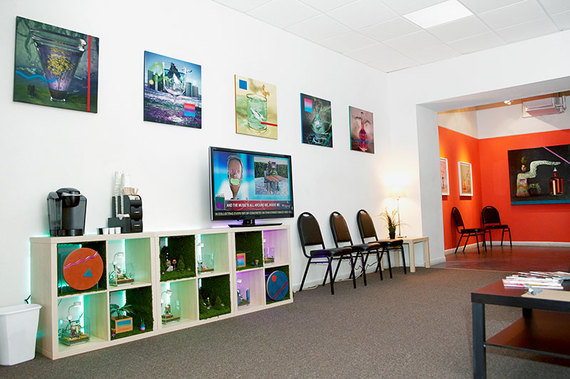Your landscapes feature a lot of neon colors and palm trees and buildings that come from different histories. What inspires your imagined landscapes?
I like to think a lot about what kind of stuff I found attractive and beautiful before anybody told me what was beautiful. Or about what gave my life meaning before I knew that life had to have a meaning. When I go back, the first thing that gave my life meaning was Super Mario. That is it, really. I was obsessed with that video game and that world. Honestly, I went to a Catholic school and they told me about Jesus so I was like, "Okay, I guess this is the thing." Then I started playing Super Mario and it replaced all that. That world gave my regular world some sort of meaning. And it had those elements; the second level of Super Mario 3 was a desert world with palm trees or something and then Mario had the nice little friendly sky world and then you went to these underground worlds where it was a little darker, just all these trippy elements really blew my little kid mind. I don't know what kind of artist I would be without Mario, honestly.
It made a big impression.
Yeah, it made a big impression on me. Just that idea of creating a character that's so fucking weird. Like what the hell is some Japanese guy doing making a character that's an Italian plumber that eats flowers and shoots magic fire at mushrooms? That idea inspires me to make these kinds of things where I'm just like what the hell am I doing? I don't even know what this is. That's like what art is sometimes. My favorite art is stuff that you don't know if it's art really. You're like, what is that? You know that's where you can generate new ideas. If you just look at something and know, "Oh, that's art," it can be so easily dismissed. But then when it's stuff that you have no idea if the thing even belongs in the space. Then I bet there's stuff going on there that you can unpack, that's new maybe.
A lot of landscape stuff is that it's New York and you never see landscapes. When I'm in my studio in front of a computer I need to compensate for that psychologically so I just want to build these kinds of landscapes to inhabit. That's kind of what this piece is about, to a certain extent. That digital space is this relatively new space for us to explore in the same way that Hudson Valley painters would go to uncharted territories of American and paint them and bring it back and then all these people would come to see it. We didn't have pictures or color photography. This is a way to explore digital space and see what it's capable of handling.
Seven or eight years ago, you were painting a lot of intricately designed and colorful worlds (architectures, little people, workspaces) that were largely rooted in realities more recognizable than some of the virtual environments that you're creating now, do you feel like those worlds share something with your more recent work?
Yeah, it all comes out of a similar sentiment, or a similar aesthetic. The colors are similar. I think those paintings aren't as weird. A lot of what I do period is me trying to learn things. With a lot of those paintings, I was just learning figure painting. I'd just plug what I was learning into some absurd system. That's really similar with this stuff. I'm learning what I can do with animation, with artificial intelligence, with programming logic. It's a pretty similar process.
I got to a point with painting where I felt like I know what this is about and now I'm going to stop doing it. I need that - that's what is generative for me, just learning new things, for better or worse. They come out of that same generative system of learning new things.
You achieve certain effects in exact detail across different media - in painting, sculpture, and video. The sense of immersion is cohesive and immediately recognizable. In the world that I was just in the texture and look of my skin looks like one of your paintings.
When I first started doing computer stuff, I would take pictures of parts of my paintings and use those textures. A lot of it is that my aesthetic sensibility comes from a certain place which is the suburbs and what was popular in the 1980s. These really cheesy rug designs and wallpaper was really big so that idea of patterning I like a lot. I think a lot of that sensibility is Nintendo games and my mom's choices from the 1980s. I think sometimes about what's at the core of your being. And it's that kind of shit, maybe. Because that's when I snapped into being, like that's what was around me or something.
Formative.
Yeah, what formed you. That's it. In the suburbs, that's it. You're in your house and then you're in this world. We went to museums sometimes. But how can you compare television and video games to a kid and then you see a painting and video games are just so much cooler. You don't learn to appreciate those painting sad stuff until you grow older. I'm trying to take all that child-like stuff into that world. And then a lot of that comes from surface and texture and those kinds of formal things.
Your work communicates with viewers across many senses - we hear stories or music, we see all kinds of things, we drink coffee - are you trying to target all five senses, or maybe more than five senses?
I'm not consciously thinking of that. I'm just trying to give people an experience. We were talking about objects earlier - I've never been interested in objects. I just don't care about objects; I don't get sentimental about them. I love throwing stuff out. So I'm less interested in creating objects. I'm more interested in creating a full experience. That's why I bring in as much shit as I can to really give people the full feeling.
That's what I appreciate in my life is the experiences I've had and the things I've done, more so than the things I have. That's what that is about.
More of Couillard's work can be seen at www.jeremycouillard.com and www.louisbjames.com. Somewhere on Mars it's Daytime and the Wind is Blowing Dust Down from a Mountain and Into a Valley will be on display in Bungalow 262 at the Miami Beach Edition from December 2-5.


